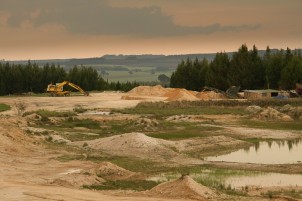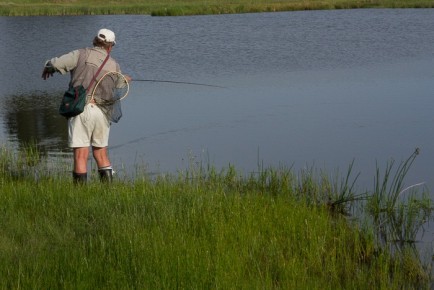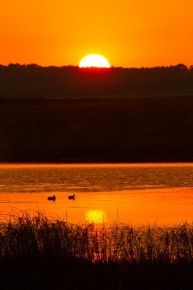
By Franz Fuls.
Lakenvlei is one of the largest and deepest peatlands in South Africa. It is under threat from planned diamond and coal mining. Sources and wetlands may be affected and various bird species on the IUCN Red List will be under severe threat. More jobs will be lost than created if mining takes place.
The wetland of Lakenvlei is located on the Steenkampsberg, a vulnerable ecological system and watershed feeding many of the major rivers passing through Eastern South Africa. It is Highland country characterised by rolling hills, forestry and farming. The economy of the Lakenvlei area relies primarily on tourism, with a strong focus on eco-tourism, directly employing more than one hundred full time workers from the local populations. If mining enters this area, these jobs will be gone, replaced by temporary jobs for as long as the mining lasts. But when the mining stops, post mining rehabilitation of peatlands is practically impossible. Leaving no jobs behind. Farming also contributes to the economy but has reduced since the area experienced a tourism boom in the mid-eighties.
The nearby town of Belfast relies on the stable and constant supply of fresh water from the Lakenvlei for its municipal water, since the peatland acts as a sponge soaking up rain and gradually releasing it over long periods of time. This also means that it acts as a buffer zone against flooding which has a positive effect downstream and into Mozambique.
Ursula Franke, Senior Field Officer from the Endangered Wildlife Trust said that the wetland and surrounding area ’falls within one of our core areas which we are striving to formally protect’.
Diamonds at Lakenvlei and the farm Middelpunt

The Lakenvlei area is pristine flyfishing country. Photo taken at a Transvaal Flyfishing Club Dam. Photo: Franz Fuls
On 16 January 2006, Ibhubesi Ore Exploration was granted a prospecting right on the farm Middelpunt on the catchment bordering upper Lakenvlei. The company proceeded with exploration without obtaining a water use license and caused great damage to a spring and wetland in the area. Pressure from neighbouring landowners resulted in a visit by Department Water Affairs who stopped prospecting operations until a water license can be produced. In the process that followed, an expert report was made which stated the importance of these wetlands and its relationship to the ‘particular(ly) important Lakenvlei.’ It rates the disturbed area as irreplaceable for terrestrial and aquatic assessments. A request for information based on the Promotion of Access to Information Act (PAIA) has been submitted to Ibhubesi/Richmond, and their response is overdue since 28 December 2012, in contravention of the requirements of the Act.
To date no direct response has been received from Mr Martiens van der Merwe, a representative of Richmond Mining and Exploration. Mr van der Merwe did state ‘submit what you like in whatever publication you like, that is no problem to us’. Due to increased pressure by local farmers and civil society it is expected that this license application will not be granted and hopes are that Ibhubesi and Richmond will own up and perform proper rehabilitation of the areas they destroyed.
Coal mining on the watershed between Lakenvlei and the source of the Elandsriver
There is an apparently non-operational sand mine on the farm Lakenvalei, alleged to be owned by William Bower. The operation stands unrehabilitated with topsoil stripped off. Mr Peter Arderne, a local farmer and veteran flyfisher is concerned about the future of the Lakenvlei: ‘The Lakenvlei is one of the largest, pristine wetlands of Mpumalanga and home to a number of endangered species. It is also a major supplier of high quality water and any inappropriate development such as mining will cause irreversible damage to the water, the sensitive fauna and flora and the sustainable eco-tourism industry which depends on this system.’
The proposed coal mining site is located directly on top of a watershed between the Olifants and Nkomati catchment areas, feeding Lakenvlei and the Elandsriver with water. According to local farmers many applications for mining rights were submitted for this area in the past, and all were declined. In March 2011, the Department of Mineral Resources received an application for a mining right from William Patrick Bower Proprietary Limited (WPB). WPB intends to extract 2 million tonnes of coal reserves over a five year life of mine, after which they would be legally required to rehabilitate. They intend creating twenty-one jobs during this period, in stark contrast to the more than one hundred direct jobs the area risks losing due to the presence of the operation. This coal reserve allegedly holds only poor quality coal.
During a public meeting that was hardly communicated by WPB, many concerns were raised. The mining can have great impact on groundwater, there were concerns related to the financial capability of WPB to rehabilitate, potential negative impacts on the Elandsriver, water quality on neighbouring farms and Lakenvlei, the effect of mining on endangered birdlife in the area, heavy vehicle traffic in a tourism area, and the potential loss of employment for up to three hundred farm and tourism workers.
A multinational consulting firm was commissioned by a local farmer to review the WPB geohydrological report. It states that the general water condition on the proposed mining site is rated as Class I (SANS241:2006) which means it is fit for lifetime consumption as is, a rare phenomenon for natural water in river systems worldwide. The specialist critiqued the report that used only one rock sample to claim that the mine will not generate acid drainage, even though the old mining sites in the area produce acid water.
Allegedly permits were issued to mine, and the local community lodged an appeal. The appeal came before the RMDEC committee who visited the site on 16 March 2012 where they were greeted by a demonstration and picketing by the local community. Sadly a great area of the topsoil that would be needed for rehabilitation seems to have vanished during the sand mining operation, which will make post mining rehabilitation near impossible or excessively expensive. To date the outcome of the RMDEC committee is not known, and the conflict between the local community and the prospective mining company seems to be indefinite.
Mr Temba Langa, director at WPB, responded to an enquiry: ‘Please note that we have already spent much effort and time consulting with interested and affected parties and cannot continue endlessly with this process. We therefore advise you to make use of certain provisions in law to access the information through the relevant regulators.’
It is unclear why governmental departments consider destructive mining applications close to Lakenvlei, with large and good quality coal reserves available in less sensitive areas and viable prospects offered by alternative energy sources.




Pingback: Sensitive South African peatland threatened by mining | Franz Fuls
Pingback: Lakenvlei Birding Trip | Franz Fuls
Peatlands/wetlands are not something you just fix after man has messed it up, when it’s damaged or destroyed that it, gone!
Has man not messed the planet up enough and even with that knowledge continues to destroy sensitive areas!
It’s all about money and someone getting rich. This mining will take place sooner or later. Almost every man has a price and if the price is paid, it will happen. Someone will issue a licence eventually. Money magnates don’t care about the planet, ecology, jobs or anything else. ONLY money means everything to these guys.